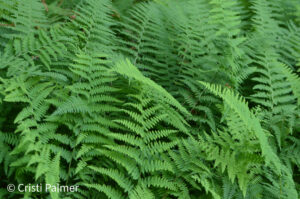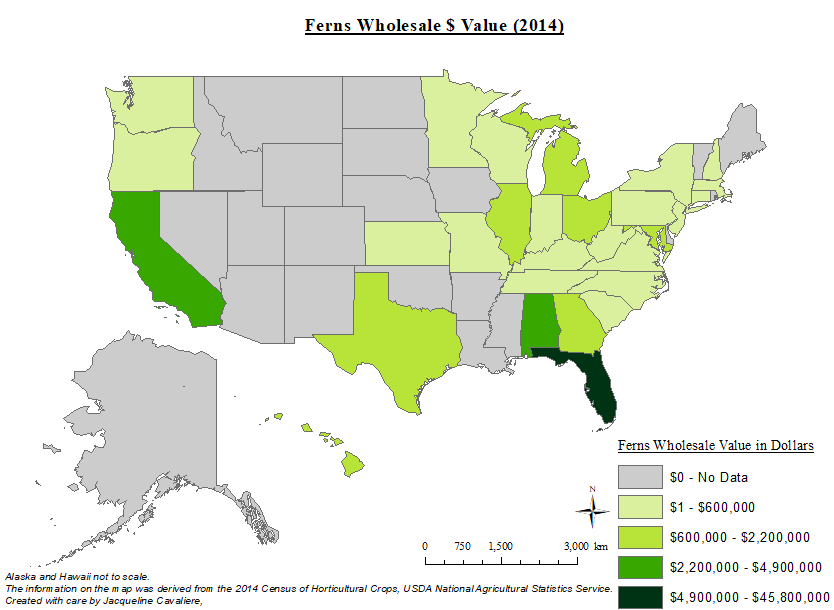Plant Information
Ferns first appear in the fossil record about 360 million years ago in the middle Devonian period, but many of the current families and species did not appear until roughly 145 million years ago in the early Cretaceous, after flowering plants came to dominate many environments. Along with club mosses, spikemosses, horsetails, and quillworts, ferns belong to the Pteridophyte family, which accounts for some of the most diverse plants on earth. Approximately 12,500 fern species are scattered worldwide. Ferns are native to every part of North America, from the hot, dry desert regions of the Southwest to the humid, moist swamps of the South to the cold mountainous areas of the North. Several non-fern plants, including the popular asparagus fern, fern bush, fern tree, fern leaf tree, are called ferns and are sometimes confused with ferns; these are not included in the technical discussion below but are included in the economic data.
Ferns do not bloom, yet they are the most ornamental of plants. Their lush foliage, diverse textures, and complex forms make them an excellent choice for a wide variety of ornamental uses. Ferns have been popular house plants for decades and ferns in hanging baskets or as potted ornamental plants are especially charming indoors or outdoors. Ferns became popular indoor plants during the Victorian Era. Today, they are used as specimens in atriums, greenhouses and conservatories and we find them in the smallest apartments to the largest homes. They offer a quiet, graceful beauty by softening landscapes indoors and out. They are also very popular items for floral arrangements, with the leatherleaf fern (Rumohra adiantiformis), a robust shade-grown fern that retains its shiny appearance and deep green color when preserved, the main crop (and the only true fern) grown for this use.
Boston ferns (Nephrolepis exaltata) are the most popular of the indoor houseplant varieties, although they also grow wild outdoors in many regions. Other popular indoor ferns include holly fern (Cyrtomium spp.), maidenhair fern (Adiantium sp.), and staghorn fern (Platycerium bifurcatum). Popular outdoor ferns that add drama to the landscape design of backyard or flower gardens, include ostrich fern (Matteucia struthiopteris), Japanese painted fern (Athyrium niponicum), Australian tree fern (Cyathea australis), bird’s nest fern (Asplenium nidus), cinnamon fern (Osmunda cinnamomea), maidenhair ferns (Adiantium sp.), Southern wood fern (Dryopteris ludoviciana), autumn fern (Dryopteris erythrosora), and royal fern (Osmunda regalis).
Ferns are extremely forgiving and have an incredibly strong survival instinct. Ferns will grow where other plants fail to thrive and most do well in rich, well-drained soil with an abundance of organic matter. Indoor ferns usually do best in bright, indirect light such as a spot a few feet from a sunny window. Ideal temperatures are between 60-70 degrees F. Most ferns appreciate humidity, and the bathroom is an ideal spot for ferns in hanging baskets. Otherwise, increase the humidity in the home with a humidifier or spritz the plant with a fine mist from time to time. Be sure fern isn’t located too near a drafty door or window, air conditioner, or heating vent. In living rooms and family rooms, stand potted ferns on trays of damp pebbles or clay granules. Growing mediums vary considerably for the many types of indoor ferns. However, all good mixtures have several things in common. They are well drained because of different components like coarse sand, gravel and charcoal. A soil mixture for ferns must hold adequate but not excessive moisture, contain organic matter and be well aerated so air can move through the soil. Apply a low dose of any liquid houseplant fertilizer every month throughout the growing season, and every other month when growth is slower during fall and winter.
Planting a fern garden outdoors requires minimal attention other than regular mulching and water during very dry periods. The basics of growing ferns in the landscape are the same as growing them in pots. Site selection in terms of drainage and light exposure is critical to production of high-quality ferns. Ferns require well-drained soil. Sandy soils or humus soils with good surface drainage are preferred. Elevated beds with amended media are excellent sites in the landscape because they ensure good aeration under most conditions. Light intensity is another key factor in site selection for plantings of ferns. Ferns either prefer or require indirect light for production of high-quality fronds (leaves). They are excellent plants for shady areas where other plants will not grow well. Avoid direct exposure to afternoon sun. Outdoors, a fern in a hanging container will generally do well with morning sunlight but needs afternoon shade. Garden ferns seldom need fertilization; use only a light slow release 10-10-10 or 15-15-15 fertilizer in the spring. Container grown outdoor ferns can be fertilized in spring, and again in midsummer if they look pale and unhealthy.
Economics
According to the USDA NASS Census of Horticulture, tropical ferns in 2014 sold for a wholesale value of $54.2M, and hardy/garden ferns for $18.5M, for a total of 72.8M annual sales.

Main Disease Problems
Ferns have a few disease problems including Pythium root rot, Rhizoctonia blight, Cylindrocladium leaf spot, bacterial blight, and nematodes.
Main Pest Problems
Ferns have a few pests including scales, mealybugs spider mites, aphids, snails, and slugs.
IR-4 Research
Most of the research IR-4 has sponsored has been related to crop safety (224 trials with 58 products), and we have screened new actives and products with ferns for effective management of liverwort (Marchantia sp.).
Sources Cited
https://en.wikipedia.org/wiki/Fern
https://garden.lovetoknow.com/types-ferns
https://www.fromhousetohome.com/garden/hardy-fern-varieties/
https://www.gardeningknowhow.com/ornamental/foliage/ferns/care-of-ferns-in-hanging-baskets.htm
https://hortscans.ces.ncsu.edu/uploads/g/r/greenhou_51dd93c8e8962.pdf
https://extension.uga.edu/publications/detail.html?number=B737&title=Growing%20Ferns
https://www.gardeningknowhow.com/houseplants/ferns-houseplants/fertilizing-indoor-ferns.htm
https://extension.psu.edu/fern-diseases
http://www.ladybug.uconn.edu/FactSheets/ferns_3_2511155032.pdf
http://www.uvm.edu/pss/ppp/articles/fernsin.html
USDA-NASS Census of Horticulture, 2018.
https://www.nass.usda.gov/Publications/Todays_Reports/reports/floran19.pdf
Authors
Ely Vea, IR-4 Environmental Horticulture Program Assistant Manager, Jacqueline Cavaliere, IR-4 Environmental Horticulture Program Coordinator, and Cristi Palmer, IR-4 Environmental Horticulture Program Manager


